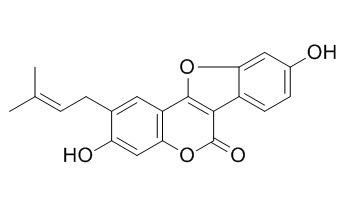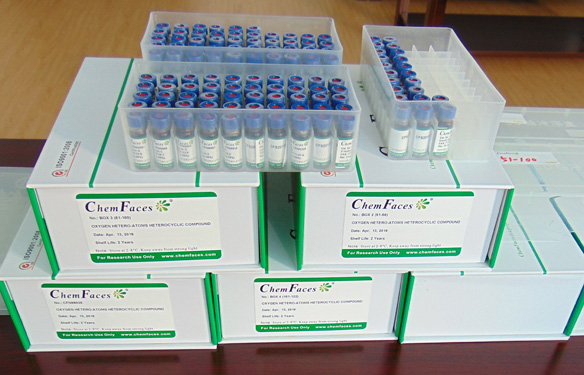Psoralidin
Psoralidin possesses potent antidepressant-like, anti-inflammatory, anticancer and chemopreventive properties. Psoralidin is a dual inhibitor of COX-2 and 5-LOX, it is also an agonist for both estrogen receptor (ER)α and ERβ agonist.Psoralidin inhibits LPS-induced iNOS expression via repressing Syk-mediated activation of PI3K-IKK-IκB signaling pathways, it induces reactive oxygen species (ROS)-dependent DNA damage and protective autophagy mediated by NOX4 in breast cancer cells.
Inquire / Order:
manager@chemfaces.com
Technical Inquiries:
service@chemfaces.com
Tel:
+86-27-84237783
Fax:
+86-27-84254680
Address:
1 Building, No. 83, CheCheng Rd., Wuhan Economic and Technological Development Zone, Wuhan, Hubei 430056, PRC
Providing storage is as stated on the product vial and the vial is kept tightly sealed, the product can be stored for up to
24 months(2-8C).
Wherever possible, you should prepare and use solutions on the same day. However, if you need to make up stock solutions in advance, we recommend that you store the solution as aliquots in tightly sealed vials at -20C. Generally, these will be useable for up to two weeks. Before use, and prior to opening the vial we recommend that you allow your product to equilibrate to room temperature for at least 1 hour.
Need more advice on solubility, usage and handling? Please email to: service@chemfaces.com
The packaging of the product may have turned upside down during transportation, resulting in the natural compounds adhering to the neck or cap of the vial. take the vial out of its packaging and gently shake to let the compounds fall to the bottom of the vial. for liquid products, centrifuge at 200-500 RPM to gather the liquid at the bottom of the vial. try to avoid loss or contamination during handling.
Food Addit Contam Part A Chem Anal Control Expo Risk Assess.2020, 37(9):1437-1448.
Industrial Crops and Products2024, 219:119123
J Biomol Struct Dyn.2023, 1-21.
Pharmaceuticals.2022, 15(4), 402.
Prev Nutr Food Sci.2024, 29(4):563-571.
University of Limpopo2016, 1777
Molecules.2020, 25(18):4283.
Pharmaceutics.2023, 15(6):1771.
Appl. Sci.2022, 12(17), 8646.
Appl. Sci. 2021, 11(22), 10552
Related and Featured Products
Phytomedicine. 2016 Aug 15;23(9):939-47.
Psoralidin induced reactive oxygen species (ROS)-dependent DNA damage and protective autophagy mediated by NOX4 in breast cancer cells.[Pubmed:
27387402]
Psoralidin (PSO), a natural phenolic coumarin, was reported to have anti-cancer activities. PSO induced reactive oxygen species (ROS) generation in cancer cells. The role of ROS in its anti-cancer effect remains unclear.
This study was designed to investigate the potential roles of ROS in PSO-induced anti-cancer effect in MCF-7 breast cancer cells.
METHODS AND RESULTS:
Effect of PSO on cancer cell proliferation was determined by MTT assay. Comet assay was used to determine DNA damage. Protein expression was detected by Western blotting. Autophagic vacuoles were detected by monodansylcadaverine (MDC) staining. ROS generation was measured by fluorescent probe. NOX4 localization was determined by immunofluorescence staining.
PSO treatment caused proliferation inhibition in time- and dose- dependent manners, which was partially reversed by N-acetyl cysteine (NAC) and diphenyleneiodonium (DPI). PSO induced DNA damage and increased protein expression of γ-H2AX, phosphorylation of ATM, ATR, Chk1, and Chk2. PSO induced autophagy as evidenced by the accumulation of autophagic vacuoles and alterations of autophagic protein expression. PSO-induced cell death was enhanced by autophagy inhibitor chloroquine (CQ). Furthermore, PSO treatment induced ROS formation, which was reversed by NAC or DPI pretreatment. The expression of NOX4 was significantly enhanced by PSO. Both NAC and DPI could reverse PSO-induced DNA damage and autophagic responses. In addition, silencing NOX4 by siRNA inhibited PSO-induced ROS generation, DNA damage, and autophagy.
CONCLUSIONS:
Taken together, these results showed that PSO induced DNA damage and protective autophagy mediated by ROS generation in a NOX4-dependent manner in MCF-7 cells.
Molecules. 2012 May 29;17(6):6449-64.
The coumarin psoralidin enhances anticancer effect of tumor necrosis factor-related apoptosis-inducing ligand (TRAIL).[Pubmed:
22643355 ]
Coumarins are a very common type of secondary plant metabolites with a broad spectrum of biological activities. Psoralidin is a naturally occurring furanocoumarin isolated from Psoralea corylifolia possessing anticancer and chemopreventive properties. Tumor necrosis factor-related apoptosis-inducing ligand (TRAIL) triggers apoptosis in cancer cells with no toxicity toward normal tissues. Endogenous TRAIL plays an important role in immune surveillance and defence against cancer cells. Coumarins can modulate TRAIL-mediated apoptosis in cancer cells.
METHODS AND RESULTS:
We examined the cytotoxic and apoptotic activities of Psoralidin in combination with TRAIL on HeLa cancer cells. The cytotoxicity was measured by MTT and LDH assays. The apoptosis was detected using annexin V-FITC staining and mitochondrial membrane potential was evaluated using DePsipher staining by fluorescence microscopy. Death receptor (TRAIL-R1/DR4 and TRAIL-R2/DR5) expression was analyzed using flow cytometry. Psoralidin enhanced TRAIL-induced apoptosis in HeLa cells through increased expression of TRAIL-R2 death receptor and depolarization of mitochondrial membrane potential.
CONCLUSIONS:
Our study indicated that Psoralidin augmented the anticancer effects of TRAIL and confirmed a potential use of coumarins in cancer chemoprevention.
Planta Med. 1996 Aug;62(4):353-4.
The cytotoxicity of psoralidin from Psoralea corylifolia.[Pubmed:
8792669]
A cytotoxic coumestan derivative, Psoralidin (1), was isolated from the seed of Psoralea corylifolia. The IC50 values of 1 against SNU-1 and SNU-16 carcinoma cell lines were 53 and 203 micrograms/ml, respectively, indicating cytotoxic activity against stomach carcinoma cell lines.
Biochem Pharmacol. 2011 Sep 1;82(5):524-34.
Psoralidin, a dual inhibitor of COX-2 and 5-LOX, regulates ionizing radiation (IR)-induced pulmonary inflammation.[Pubmed:
21669192]
Psoralidin, a coumestan derivative isolated from the seed of Psoralea corylifolia, has been studied for anti-cancer and anti-bacterial properties. However, little is known regarding its effects on IR-induced pulmonary inflammation. The aim of this study is to investigate mechanisms of IR-induced inflammation and to examine therapeutic mechanisms of Psoralidin in human normal lung fibroblasts and mice.
METHODS AND RESULTS:
Here, we demonstrated that IR-induced ROS activated cyclooxygenases-2 (COX-2) and 5-lipoxygenase (5-LOX) pathway in HFL-1 and MRC-5 cells. Psoralidin inhibited the IR-induced COX-2 expression and PGE(2) production through regulation of PI3K/Akt and NF-κB pathway. Also, Psoralidin blocked IR-induced LTB(4) production, and it was due to direct interaction of Psoralidin and 5-lipoxygenase activating protein (FLAP) in 5-LOX pathway. IR-induced fibroblast migration was notably attenuated in the presence of Psoralidin. Moreover, in vivo results from mouse lung indicate that Psoralidin suppresses IR-induced expression of pro-inflammatory cytokines (TNF-α, TGF-β, IL-6 and IL-1 α/β) and ICAM-1.
CONCLUSIONS:
Taken together, our findings reveal a regulatory mechanism of IR-induced pulmonary inflammation in human normal lung fibroblast and mice, and suggest that Psoralidin may be useful as a potential lead compound for development of a better radiopreventive agent against radiation-induced normal tissue injury.
Oncol Lett. 2016 Aug;12(2):971-976.
Psoralidin inhibits proliferation and enhances apoptosis of human esophageal carcinoma cells via NF-κB and PI3K/Akt signaling pathways.[Pubmed:
27446379]
Esophageal cancer is the most common gastrointestinal cancer. Psoralidin exhibits antioxidant, anti-apoptotic, anti-inflammatory and antitumor effects, which result in the inhibition of cancer formation.
METHODS AND RESULTS:
The present study aimed to investigate the effect of Psoralidin on esophageal carcinoma proliferation and growth, and to elucidate its underlying mechanism of action. The effect of Psoralidin on cell proliferation was investigated using 3-(4,5-dimethylthiazol-2-yl)-2,5-diphenyltetrazolium bromide assay. Using an annexin V-fluorescein isothiocyanate/propidium iodide apoptosis detection kit and 4',6-diamidino-2-phenylindole staining assay, the present study demonstrated that Psoralidin significantly enhanced apoptosis of human esophageal carcinoma Eca9706 cells. In addition, caspase-3 activity was analyzed with a caspase-3 colorimetric assay kit, while nuclear factor (NF)-κB activity and protein phosphatidylinositol 3-kinase (PI3K)/Akt expression were measured with an NF-κB enzyme-linked immunosorbent assay kit and western blot analysis, respectively. Eca9706 cells were treated with a PI3K agonist in order to investigate the mechanism of action of Psoralidin. It was observed that Psoralidin was able to decrease the proliferation and promote the cellular apoptosis of Eca9706 cells in a dose-dependent manner. Furthermore, Psoralidin was also able to inhibit the caspase-3 activity of Eca9706 cells in a dose-dependent manner. In addition, Psoralidin inhibited NF-κB activity and reduced PI3K and Akt protein expression in Eca9706 cells. Notably, the PI3K agonist was able to reverse the effect of Psoralidin on Eca9706 cells.
CONCLUSIONS:
The results of the present study demonstrated that Psoralidin was able to inhibit proliferation and enhance apoptosis of human esophageal carcinoma cells via the NF-κB and PI3K/Akt signaling pathways.
Bioorg Med Chem Lett. 2014 Mar 1;24(5):1403-6.
Psoralidin, a coumestan analogue, as a novel potent estrogen receptor signaling molecule isolated from Psoralea corylifolia.[Pubmed:
24507928]
A novel biological activity of Psoralidin as an agonist for both estrogen receptor (ER)α and ERβ agonist has been demonstrated in our study.
METHODS AND RESULTS:
Psoralidin has been characterized as a full ER agonist, which activates the classical ER-signaling pathway in both ER-positive human breast and endometrial cell lines as well as non-human cultured cells transiently expressing either ERα or ERβ. The estrogenic activity was determined using the relative expression levels of either reporter or the endogenous genes dependent on the agonist-bound ER to the estrogen response element (ERE). Psoralidin at 10 μM was able to induce the maximum reporter gene expression corresponding to that of E2-treated cells and such activation of the ERE-reporter gene by Psoralidin was completely abolished by the cotreatment of a pure ER antagonist, implying that the biological activities of Psoralidin are mediated by ER. Psoralidin was also able to induce the endogenous estrogen-responsive gene, pS2, in human breast cancer cells MCF-7. It was observed that activation of the classical ER-signaling pathway by Psoralidin is mediated via induction of ER conformation by Psoralidin and direct binding of the Psoralidin-ER complex to the EREs present in the promoter region of estrogen-responsive genes, as shown by chromatin immunoprecipitation assay results.
CONCLUSIONS:
Finally, molecular docking of Psoralidin to the ligand binding pocket of the ERα showed that Psoralidin is able to mimic the binding interactions of E2, and thus, it could act as an ER agonist in the cellular environment.
Eur J Pharmacol. 2011 Jan 10;650(1):102-9.
Psoralidin inhibits LPS-induced iNOS expression via repressing Syk-mediated activation of PI3K-IKK-IκB signaling pathways.[Pubmed:
20951127]
Psoralidin has been reported to inhibit lipopolysaccharide (LPS)-induced nitric oxide (NO) production, but the mechanisms of the action remain unclear. Thus, the impact of Psoralidin on signaling pathways known to be implicated in NO synthesis was explored in LPS-activated RAW264.7 macrophages by using RT-PCR and Western blotting. Consistent with NO inhibition, Psoralidin suppressed LPS-induced expression of inducible NO synthase (iNOS) by abolishing IκB kinase (IKK) phosphorylation, IκB degradation and nuclear factor κB (NF-κB) nuclear translocation without effecting mitogen-activated protein kinases (MAPKs) phosphorylation. Exposure to wortmannin abrogated IKK/IκB/NF-κB-mediated iNOS expression, suggesting activation of such a signal pathway might also be phosphoinositide-3-kinase (PI3K) dependent. By using Src inhibitor PP2, Janus kinase 2 (JAK-2) inhibitor AG490, Bruton's tyrosine kinase (Btk) inhibitor LFM-A13 and spleen tyrosine kinase (Syk) inhibitor piceatannol, the results showed that piceatannol clearly repressed NO production more potently than the other inhibitors. Furthermore, piceatannol significantly repressed LPS-induced PI3K/Akt phosphorylation and the downstream IKK/IκB activation, suggesting that Syk is an upstream key regulator in the activation of PI3K/Akt-mediated signaling. In fact, transfection with siRNA targeting Syk obviously reduced iNOS expression. Interestingly, LPS-induced phosphorylations of Syk and PI3K-p85 were both significantly blunted by Psoralidin treatment.
CONCLUSIONS:
The present results show that interfering with Syk-mediated PI3K phosphorylation might contribute to the NO inhibitory effect of Psoralidin via blocking IKK/IκB signaling propagation in LPS-stimulated RAW 264.7 macrophages.
Prog Neuropsychopharmacol Biol Psychiatry. 2008 Feb 15;32(2):510-9.
Antidepressant-like effects of psoralidin isolated from the seeds of Psoralea Corylifolia in the forced swimming test in mice.[Pubmed:
18006202 ]
The antidepressant-like effects of Psoralidin isolated from the seeds of Psoralea corylifolia were investigated in the forced swimming test (FST) in ICR strain of male mice.
METHODS AND RESULTS:
Psoralidin significantly decreased immobility time and increased swimming behavior without altering climbing behavior in the mouse FST after oral administration for 1 h or 3 consecutive days. Psoralidin did not affect locomotor activity in the open-field test. After a 3-day treatment, Psoralidin significantly increased 5-hydroxytryptamine (5-HT) and 5-hydroxyindoleacetic acid (5-HIAA) levels in various brain regions, as well as, changed dopamine (DA) levels in striatum in mice exposed to FST. Psoralidin also ameliorated the elevations in serum corticotropin-releasing factor (CRF), adrenal corticotropin-releasing hormone (ACTH) and corticosterone concentrations induced by swimming stress in mice.
CONCLUSIONS:
These results suggested that Psoralidin possessed potent antidepressant-like properties that were mediated via the monoamine neurotransmitter and the hypothalamic-pituitary-adrenal (HPA) axis systems.



